
Banksia purdieana is a species of bushy shrub that is endemic to Western Australia. It has broadly linear, pinnatipartite leaves with sharply-pointed lobes on the sides, yellow flowers in heads of about eighty and egg-shaped follicles.
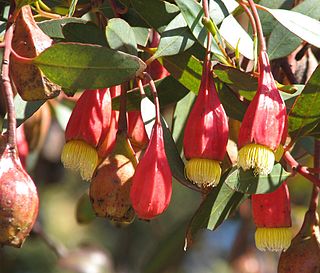
Eucalyptus forrestiana, commonly known as fuchsia gum or fuchsia mallee, is a species of small tree or mallet and is endemic to an area near Esperance, Western Australia. It has smooth grey bark, narrow oblong to lance-shaped adult leaves, flower buds that are square in cross-section, red at maturity and arranged singly in leaf axils, yellow flowers and four-angled, winged fruit.

Verticordia pritzelii, commonly known as Pritzel's featherflower, is a flowering plant in the myrtle family, Myrtaceae and is endemic to the south-west of Western Australia. It is a compact, woody shrub with several main stems, small, linear to club-shaped leaves, and rounded groups of deep pink flowers from late spring to mid-summer.

Calectasia intermedia, commonly known as blue tinsel-lily or eastern tinsel lily is a species of flowering plant in the family Dasypogonaceae, endemic to the border areas of western Victoria and south-eastern South Australia and flowering in early spring. It is the only member of the genus Calectasia that is not endemic to Western Australia.

Isopogon alcicornis, commonly known as the elkhorn coneflower, is a plant in the family Proteaceae and is endemic to part of the south coast of Western Australia. It is a low shrub with pinnately-lobed leaves and oval heads of hairy, white or pink flowers.
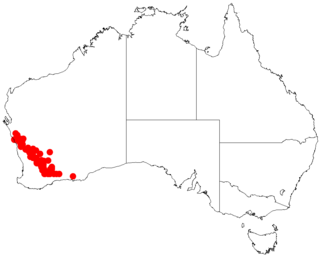
Acacia dielsii, commonly known as Diels' wattle, is a shrub of the genus Acacia and the subgenus Plurinerves that is native to Western Australia.
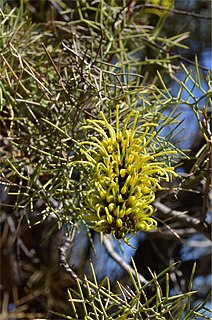
Hakea divaricata, commonly known as needlewood, corkbark tree or fork-leaved corkwood, is a tree or shrub in the family Proteaceae native to an area in central Australia. A slow growing species with up to 120 showy cream to greenish-yellow flowers in long racemes from June to November.

Hakea invaginata is a shrub in the family Proteacea and is endemic to Western Australia. It has purplish-pink flowers, smooth needle-shaped leaves and the branchlets are thickly covered in hairs.
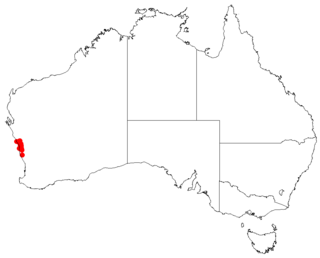
Hakea polyanthema is a shrub in the family Proteacea with small unpleasantly scented flowers in profusion in the leaf axils. It is endemic to Western Australia.

Gunniopsis is a genus of flowering plants in the iceplant family, Aizoaceae. These plants are found in areas of inland Australia.
Gunniopsis quadrifida, the Sturts pigface, is a plant endemic to Australia that is within the family Aizoaceae. This family consists of a diverse array of species that inhabit arid and/or saline coastal and inland areas, with the plants displaying leaf morphology that is conducive to such harsh environments. Typical features of members of this genus that lie within this family of succulents includes the presence of fleshy-leaves that acts as a water reservoir for the plant with the habit of a smalls shrub.
Gunniopsis calcarea, commonly known as the Nullarbor Gunniopsis or the yellow flowered pigface, is a succulent plant in the iceplant family, Aizoaceae. It is endemic to Australia.
Gunniopsis zygophylloides, commonly known as the twin-leaf pigface, is a succulent plant in the iceplant family, Aizoaceae. It is endemic to Australia.
Gunniopsis divisa is a succulent plant in the iceplant family, Aizoaceae. It is endemic to Western Australia.
Gunniopsis calva, commonly known as the smooth pigface, is a succulent plant in the iceplant family, Aizoaceae. It is endemic to Australia.
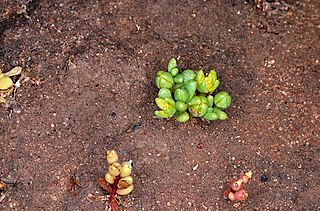
Gunniopsis septifraga, commonly known as green pigface, is a species of flowering plant in the iceplant family, Aizoaceae and is endemic to Australia. It is a prostrate to tuft-forming annual herb, with oblong to lance-shaped leaves and small greenish flowers, that grows around salt lakes.
Gunniopsis glabra is a succulent plant in the iceplant family, Aizoaceae. It is endemic to Western Australia.
Gunniopsis rodwayi is a succulent plant in the iceplant family, Aizoaceae. It is endemic to Western Australia.

Gunniopsis papillata, commonly known as the twin-leaved pigface, is a species of succulent plant in the iceplant family, Aizoaceae and is endemic to inland areas of Australia. It is an annual herb with pimply, spatula-shaped to egg-shaped leaves and flowers with white or yellow petals.

Teucrium eremaeum is a species of flowering plant in the family Lamiaceae and is endemic to the south-west of Western Australia. It is a perennial herb or shrub with small, linear to lance-shaped leaves and white or cream-coloured flowers.













